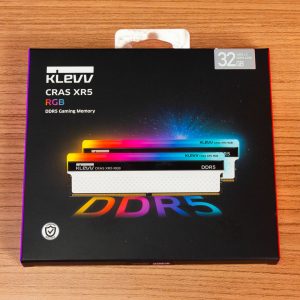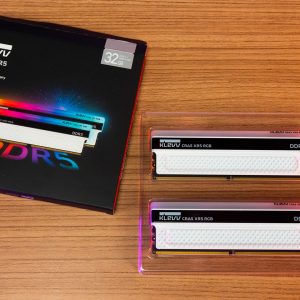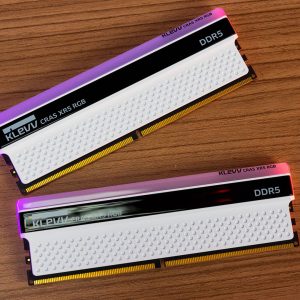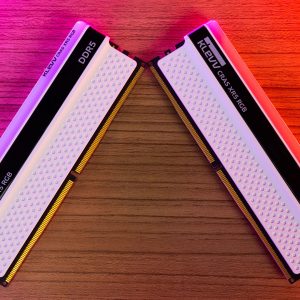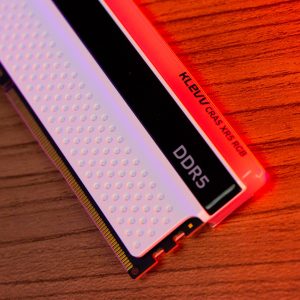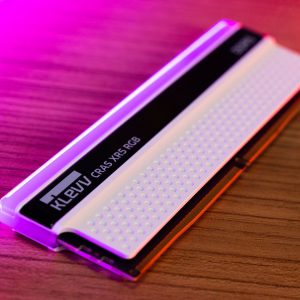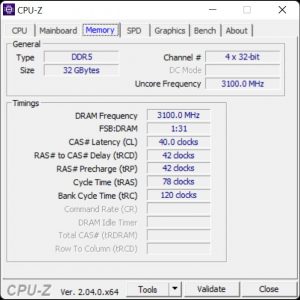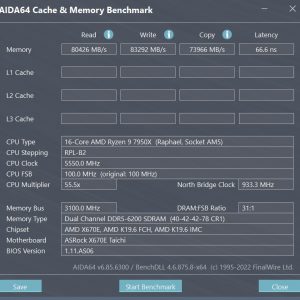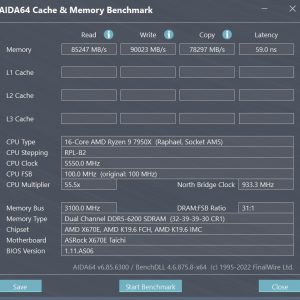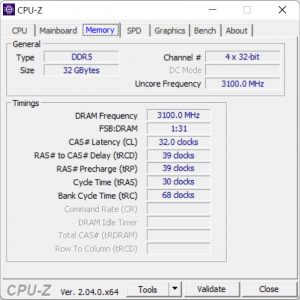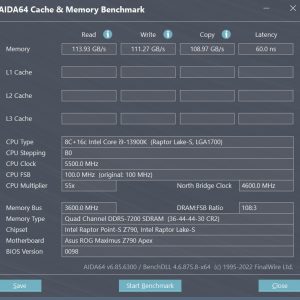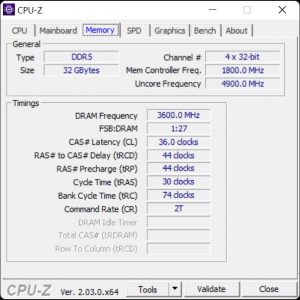Since DDR5 memory is made available to the consumer market, it didn’t take long for the enthusiasts and overclockers in the community to find out which one is the best for their needs. With both the latest Intel and AMD platform now supporting DDR5 memory, it’s no longer something that is exclusive to the blue camp. Unlike what we see on DDR4, DDR5 with SK Hynix chips is currently the better option when it comes to overclocking.
KLEVV, as one of the renowned memory products manufacturers, is known for using SK Hynix memory chips and that goes the same for the KLEVV CRAS XR5 RGB DD5-6200 which we will be featuring in this article. So, let’s see how well the KLEVV CRAS XR5 RGB DD5-6200 performs on both our Intel and AMD test systems.
Specifications
| Capacities | Kits of 2: 32GB |
| Speeds* | 6000MT/s, 6200MT/s |
| Latencies | CL40 |
| Voltage | 1.3V |
| Operating Temperature | 0 °C to 85 °C |
| Dimensions | 137.4 mm x 42.5 mm x 8.3 mm |
Unboxing
The CRAS XR5 RGB is one of the latest DDR5 memory kits from KLEVV, which comes available in two variants: DDR5-6000 and DDR5-6200. It doesn’t have any variant that is above DDR5-6200 like some but I think it’s fair enough for now, especially for the new AMD platform.
Like most of the DDR5 kits nowadays, there are not many that will actually come with any fancy extras but that’s okay. Design-wise, the CRAS XR5 RGB is almost identical to the CRAS XR RGB, featuring the same heat spreader design in white color and debossed patterns, mirror finish strips, and the RGB lightbar.
While it does come with SK Hynix memory chips that are known to scale better with higher voltage and able to achieve higher memory frequencies compared to Micron and Samsung, SK Hynix has actually released its new A-die memory chips that can go even further compared to the existing M-die. We’re unsure which of the KLEVV DDR5 memory kit is currently using the SK Hynix A-die but we have confirmed that our kit here is using the M-die, which is still decent for overclocking. It can be identified by the label on the memory chip H5CG48MEBDX014.
Test System
| CPU | Intel Core i9-13900K |
| Motherboard | ASUS ROG Maximus Z790 APEX |
| Memory | KLEVV CRAS XR5 RGB DDR5-6200 |
| Graphics Card | NVIDIA GeForce RTX 3080 |
| Power Supply | Cooler Master V1200 Platinum |
| Primary Storage | Kingston KC3000 2TB |
| Secondary Storage | WD Black 6TB |
| CPU Cooler | Cooler Master MasterLiquid PL360 Flux |
| Chassis | Cooler Master MasterFrame 700 |
| Operating System | Windows 11 64bit |
Memory Overview
The CRAS XR5 RGB comes with only one XMP profile of DDR5-6200 CL40 but despite having only the XMP profile, it actually works fine on the latest AMD platforms despite not being EXPO certified. And because of that, the naming for the profile might be different on the motherboard you’re using.
From our test on an ASRock X670E Taichi motherboard, the XMP profile works just fine but that’s about it when it comes to the memory latency. Unless you adjust the timings manually, the memory latency you’ll be getting is going to be within the range of 65ns. If you prefer to stick with the DDR5-6000 settings which AMD claims to be the sweet spot for Zen 4, the easiest adjustment is probably something like the following while leaving the tCL, tRP, and tRCD on stock XMP settings:
- DRAM VDD and VDDQ: 1.35V
- VDDIO: 1.35V
- VSOC: 1.25V
- tRAS: 30
- tRFC/tRFC2/tRFC4: 500/400/300
If you want to slightly optimize it from the stock XMP profile, DDR5-6200 CL32 is achievable using the same method but it will require a higher voltage value to stay stable. For our case, we’re using DRAM VDD/VDDQ, VDDIO at 1.43V, and VSOC at 1.3V.
The behavior is different on the Intel platform of course, and you can achieve higher memory frequencies a lot easier, especially on the latest Intel 13th-gen Core processors and Z790 chipset motherboards. Just for the fun of it, we gave it a little push, and is able to achieve DDR5-7200 CL36. At this frequency, higher voltage is required to maintain stability and we’re able to clear the memory stress test on TestMem5 and at least 2000% on Karhu RAM test using the following values:
- DRAM VDD/VDDQ: 1.68V
- TX VDDQ:1.413V
- memory controller: 1.381V
- System Agent: offset 0.15V
Final Thoughts
Since it’s pretty much identical to the CRAS XR RGB DDR4 design, it’s just the kind of design that I’m really into despite not being a fan of RGB lighting. The only issue for some is probably the white-colored heat spreader, which can be a pain for users who prefers a dark-colored accent for their system. As for those of you who are into builds with white color accents, the CRAS XR5 RGB is definitely what I’d recommend just for the aesthetics alone.
Despite both AMD and Intel now supporting DDR5 on their latest platforms, we can still see some AMD users struggling with DDR5-6200 despite the kit being listed on the QVL for the motherboard you’re using. While we did manage to get the KLEVV CRAS XR5 RGB DDR5-6200 to run just fine on both our AMD and Intel test bench, the current frequency that I think is the best for the mass is still DDR5-6000. Not only that it’s a lot easier to achieve on both platforms with almost no effort, but it also gives a significant improvement over the standard DDR5-4800, especially for gaming. Though unlike DDR5 kits that is using the SK Hynix A-die, kits with SK Hynix M-die will require some tweakings to bring out the better performance it can actually deliver, which applies to the KLEVV CRAS XR5 RGB DDR5-6200 as well.
Overclocking-wise, although DDR5 memory kits using the SK Hynix A-die are the new meta right now, that doesn’t means that the previous DDR5 memory kit that uses the M-die is inferior. It does use more power as compared to kits that is using the A-die chips but it doesn’t stop us from achieving the desired results. The KLEVV CRAS XR5 RGB is a clear example of that, as it doesn’t take much effort to run perfectly on the new AMD platform and easily achieve DDR5-7200 on the new Intel platform. Though this shouldn’t be the main consideration when it comes to picking the DDR5 kit for your system and I will always recommend a reasonable kit that can do DDR5-6000 at the best possible price instead of chasing for numbers that are impractical for the majority of the mainstream users.
Now for the price, we have yet to receive any updates on the local price yet but the KLEVV CRAS XR5 RGB DDR5-6200 will be retailed at US$170 when it finally hits the shelves in late February 2023. While it’s still pretty costly to some but if you’ve been following the market price for DDR5 since Intel first launched its 12th-gen Core processors and Z690 chipset motherboards, it’s actually way lower right now. So, is the KLEVV CRAS XR5 RGB DDR5-6200 worth to be recommended? Well, yes but only if you have plans to overclock it. Else, the DDR5-6000 variant is probably the better choice.
Pros
- Intel XMP 3.0 ready
- Compatible with Intel 12th/13th gen K CPUs and Z690/Z790 motherboards
- Reasonable overclocking headroom on Intel Z690/Z790 motherboards
- Limited lifetime warranty from KLEVV
Cons
- Limited overclocking headroom on AMD Zen 4 CPUs and AM5 motherboards
- Only available in white color for now



